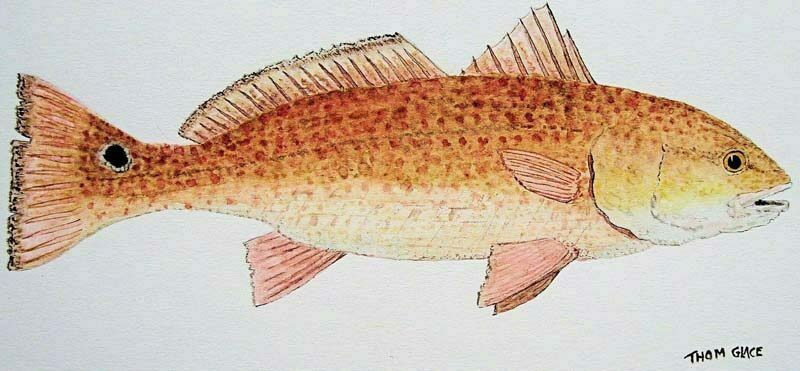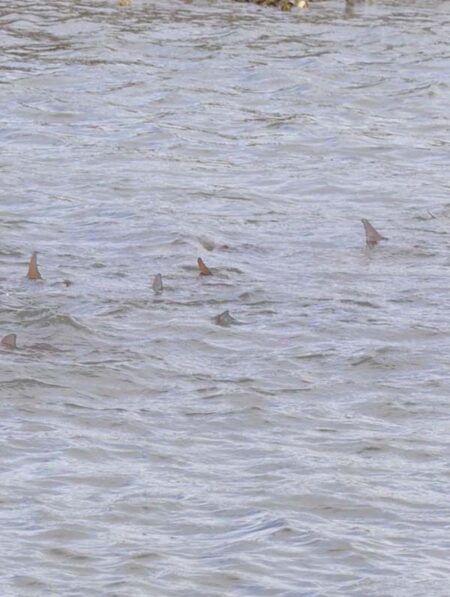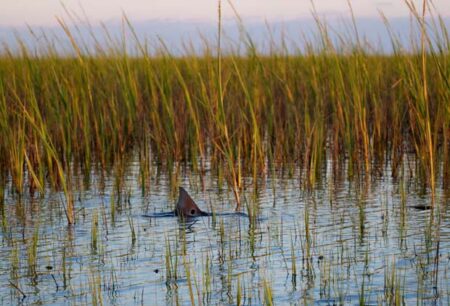
Redfish study by Thom Glace. Used with permission.
In coastal Georgia, it’s all about reds
By Skip Clement
Reds do not fight like many other flats dwellers, but they challenge like a heavyweight in the early rounds. Their specialness is in most coastal waters are that you’re sight fishing. The true pleasure of fly fishers.
The red drum (Sciaenops ocellatus) is also called redfish, channel bass, spottail, red bass, or reds and is one of the most popular sport fish for anglers of every stripe. It’s a widespread estuarine fish that’s a target from North Carolina to Texas and throughout the Gulf of Mexico states.
It is named after its ‘drumming’ sound during spawning and when taken out of the water. The sound is produced by muscles rubbing against an inflated air bladder.
Juvenile red drum inhabits rivers, bays, salt marshes, fresh water, canals, and tidal creeks and passes in estuaries for up to four years (about 4-pounds for males and 6-pounds for females), after which they usually move to nearshore or open ocean waters as adults. However, some populations of reds stay inshore for their lifetime (South Florida, for example).
The world record red drum was caught off North Carolina waters in 1984 and it weighed 94-pounds, 2-ounces. The oldest recorded red drum was aged 40 years (Florida).

Lowcountry tailers near Sea Island, Georgia. Image by Golden Isles Fly Fishing
Reds feed on crabs, mullet, pinfish, and killifish (mud minnows)
- The most popular fly fishing is sight fishing and the red drum offers that opportunity throughout its ranges. There are, however, many different fishing tactics.
- The largest reds are found in North Carolina and Louisiana bayou waters.
- Redfish are prolific spawners (a single female will produce tens of millions of eggs each year).
- They’re much hardier than snook and bonefish because they can withstand much colder water and tolerate being hatchery-reared.
- Fishing restrictions have restored their populations. However, each state has its regulations – be sure to be up to speed on that issue.
Red Drums are reddish brown on the back, fading to white below. Juveniles have a copper or bronze tint. Most Red Drum have one distinctive black spot at the base of the tail, but some have several spots – others have none.
In the Gulf of Mexico, reds are lighter than those in muddy bays. When taken from the water, the fish may turn a darker red
Red Drums thrive in a wide range of salinities and temperatures, an adaptation that suits their versatile lifestyle. Juveniles can tolerate fresh water, whereas larger reds prefer higher salinities. They are comfortable from 50°F to about 81.5°F water. Small Red Drum can withstand a greater range, from about 36°F to 91°F. However, they are vulnerable to sudden temperature drops and will move into warmer, deeper waters during cold spells.
Fishing for reds:
- Unless they’re tailing or producing a wake, you’ll probably come upon them and be too close or just plain spook them. Proceed with caution.
- You don’t need to cast a mile, but you do have to be accurate. Do not drag the fly into the fish – the fly would be viewed as a predator and the fish is gone.
- Unless a crab pattern, keep your fly moving at a steady pace (bait or streamer-like pattern), especially if the fish shows interest – if you stall or speed up – it’s gone. However, you can retrieve a distinctly obvious shrimp pattern because that’s how they ambulate.
- Although they have a broad palate for flies, they stay with diet favorites patterns.
Crab pattern fishing tactics:
Casting to a tailing redfish 45-feet away in heavy grass is problematic, but if you remember that crabs don’t flea, they submerge, you’ll do fine using the following tactic. Again, it’s only a short cast, but it must be accurate. Judge the direction the tailer is heading and drop your fly about 2 feet in front and don’t do anything but wiggle the LINE – using only your wrist to enact the scene. In thick grass – moving the fly will only get you hung up, so be patient. A little movement of a leaf will attract the attention of an approaching and feeding/tailing red. It’s almost a foolproof tactic.

For fly fishers of the flats, no matter how many times this situation arises it’s like surprise sex – always good. Golden Isles Fly Fishing
Here are just a few patterns:
- Chris Dean’s yarn crab (brown)
- Clouser Minnows (multiple color combos)
- Enrico Puglisi Redfish Special
- Spawning Shrimp (Any color in the larger sizes)
- Borski’s Chernobyl Crab
- Merkin Crab
Note:
- Go with whatever the guide suggests.
- Do not be upset if they dismiss your choices.
- Remember, this is their living; they want you to catch a redfish more than you do.
Click here to view Golden Isles Fly Fishing charters website . . .
Phone: 912-617-1980
Skip Clement, New Zealand.
Click here to view Golden Isles Fly Fishing charters website …
Phone: 912-617-1980
NOTE: The author is proud to have been part of a coalition of three that finally convinced the Great State of Georgia to prohibit commercial harvest of redfish.
ATLANTA May, 2013: Redfish [Sciaenops ocellatus] will either have to catch it themselves or buy it from someone out of state now that Georgia has a new law prohibiting its commercial harvest.
Gov. Nathan Deal signed into law House Bill 36, sponsored by Rep. Ben Watson, R-Savannah. It formally designates the red drum as a ‘game fish,’ limiting it to recreational fishing.
The measure was supported by sportsmen who complain it’s become too hard for them to catch the fish that is popular as a fighter. They argue saving the fish from commercial harvest will leave them as a draw for tourists who’ll bring economic benefits. — The Times-Union



